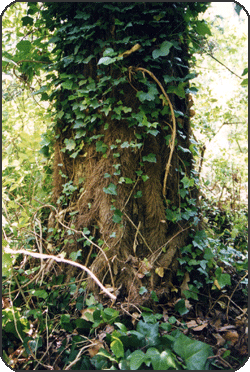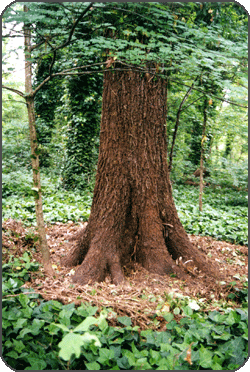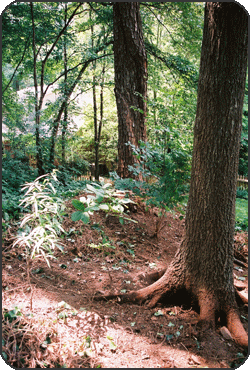Machete Man is a specialized service that cuts invasive plants away from trees and neighboring fences or walls particularly where these vines or shrubs have become established over long periods of time. The removal of such long-term infestations is particularly challenging for unskilled and inexperienced workers to carry our efficiently and without damaging the trees and secondary succession (see Kricher & Morrison, 1988. In the case of English Ivy, for example, an infestation over many years results in the trunk of the supporting tree becoming almost completely encased in a solid, curved plate of woody, vine material that requires very skillful hard work to remove without damage to the tree.
The fees charged for Machete Man services all go to help support the School’s conservation activities so there is a particularly meaningful synergy established: By saving trees from the threats posed by invasive plant species, support is obtained to increase knowledge about, and awareness of, the significance of forest conservation in general.
For additional details of Machete Man services go to
www.macheteman.com

A heavy infestation of ivy encases the base of this tree

The cleaned bole of an oak contrasts with the ivy-infested trees in the background; private garden in the Fernbank forest.
A critical element of this service is that the work is carried out with both ecological and esthetic sensitivity.
All invasive plant material is removed from the bole of the tree up to a height of about 9 ft. so that the natural beauty of the tree is revealed. This contrasts with the way that herbicidal sprays are used to kill the vines where the dead vine material remains on the tree at its most conspicuous level;

Small saplings visible to the left of a cleaned tree: Garden in Sandy Springs
- The skillful, controlled use of a machete results in little or no marks being left on the bark of the tree. Experience has shown that attempts have been made to treat English Ivy infestations by using chainsaws resulting in unsightly and potentially harmful cuts to the tree. Similar damage to trees has been seen resulting from uncontrolled use of bladed implements;
- Root systems of the invasive plants can be treated in a way that leads to eradication of the infestations without contaminating the soil or use of herbicidal sprays that can kill native plants;
- Invasive material is cut away from the base of the tree and the ground around it to a distance of 2 ft., and as many roots mechanically removed from the area at the same time. This is done with special regard to save native tree seedlings and saplings that would normally be killed with a wholesale approach using mechanical trimmers or undiscriminating workers;
- In this same context, when major infestations of Privet are cut out, great care is taken to make sure that no native tree seedlings or saplings are cut in the process. Young, native trees that have managed to survive in such contexts are relatively rare but already have an established root system and, hence, constitute the first, strong steps toward establishing the new ‘forest of the future’ (see Invasive Species, Ecological Rationale);
- The vine and shrub material that is cut-away from the tree is not thrown away (i.e., removed to a land fill) but positioned so as to prevent soil erosion and further impede any “grow-back” of vines from the surrounding area. As this material decomposes, essential minerals are slowly released back into the soil and become available to the remaining native trees. At the same time, the material becomes a habitat for wildlife; the wide range of invertebrate species that become established in these micro-environments provide, in their turn, a food resource for small mammal and bird species;
- Small trees that have been inundated by such vines as Wisteria ort Kudzu are not just cut out from the invasive vines but appropriately trimmed and (where necessary) propped up so as to direct a long-term, healthy growth pattern.
If you wish to train as a Machete Man, visit the Web Site (see above) and contact Dr. J.F. Dahl at deepforestfieldschool@gmail.com.
